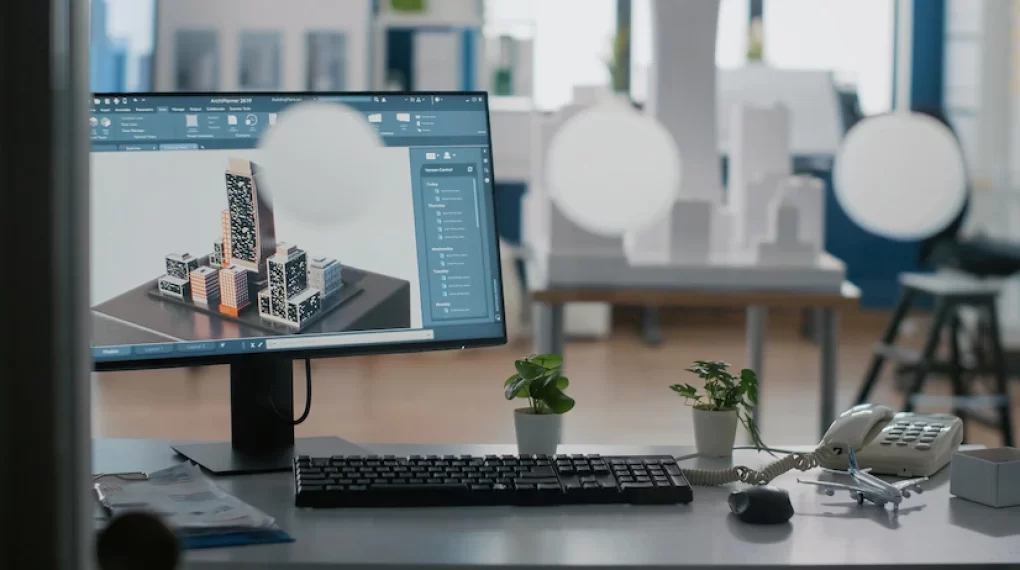
We all spent hundreds of hours glued to our screens, making those magic castles and unreal buildings in Minecraft. I still have my dream house perfectly laid in those funky pixelated bricks.
I always imagined having a room tour through it, with the view of the vineyard from the living room, but it was just that – a fairy tale imagination.
But everything changed when the Unreal Engine and its cutting-edge features came into architectural design.
How Unreal Engine changed architectural design forever
Gone are the days of pulling all-nighters and drafting an outlook of your perfect building. In 2023 it seems even crazy being Ted from HIMYM, doing everything on paper or in AutoCAD.
Hold on, wait a sec before you throw your design curses on me. Let me explain. Imagine you have a giant sandbox in your backyard, and inside that sandbox is a miniature version of your dream home. You can spend hours building and perfecting every little detail, from the color of the walls to the type of flooring.
But there’s a catch — you can only see your mini dream home in your mind. You can turn some pieces into 2D with AutoCAD, but that’s where the magic stops.
Introducing Unreal Engine, the magical tool that brings your mini-dream home to life in all its glory. It’s like a genie in a bottle, except instead of granting wishes, it grants the ability to see your architectural creations with all the stunning, realistic, and interactive details.
It’s like playing with Legos, except on a much greater scale with mind-blowing virtual environments (and without the risk of stepping on a stray piece in the middle of the night).
On a broader scale, Unreal Engine changed how we adopt new tech. With a gamification approach to creating new realities, there’s no wonder why this tool is in heavy demand.
Key features that turned Unreal Engine into the asset every architect wants
Unreal Engine is Epic Games’ most praised child. There almost isn’t a soul in the gaming, animating, film producing, and architecture industry that doesn’t love it!
The shear power of this real-time 3D creation platform lies in these features:
- Ability to create incredibly realistic and micro-detailed environments.
- Believable and coherent look.
- Open use of blueprints and visual scripting.
- Power to connect to different 3D software like Blender, Cinema 4D, AutoCAD, and others.
But how does Unreal Engine do it? How does it create such immersive and interactive experiences we’ve never seen before in the architectural industry?
The secret of Unreal Engine in architectural design

To craft such unbelievably realistic architectural results, Unreal Engine uses something called Physically Based Rendering (PBR).
PBR is a rendering technique that focuses on mimicking the behavior of light in the real world. It’s like a digital camera for your computer, but instead of using film or a digital sensor to capture light, PBR uses math and algorithms to simulate the way light interacts with surfaces in a 3D environment.
Here’s the technical part: PBR uses the principles of physics to calculate how light reflects off of a surface, taking into account the surface’s material properties (such as its reflectivity, roughness, and refractive index) and the properties of the light itself (such as its intensity, color, and spectrum).
That gives PBR the power to create more realistic and believable images, as the lighting and materials in the scene behave in a way that is consistent with the real world.
Now for the funny part: PBR is like a party for light and surfaces. The light bounces around, trying to show off its fancy colors and shadows, while the surfaces try to act all cool and reflective. It’s a wild and wacky scene, but at the end of the day, PBR makes sure everything stays grounded in reality by following the laws of physics.
So grab a drink and join the party!
The secret numero duo
PBR isn’t the only magic trick up Unreal Engine’s sleeve. Visual scripting and the ability to interact with your environment through VR and AR strategy is what makes this 3D platform even more special.
Imagine this: You’re an architect that just finished designing a new building. You want to show your client what it’ll look like, but instead of just showing them a bunch of boring drawings or static images, you decide to use VR and AR to bring the design to life!
With VR, you can strap on a headset and take your client on a virtual tour of the building. They can walk through the space and see what it looks and feels like from different angles. Push it even further and VR will simulate different lighting conditions or weather, so your client sees how the building will look on a sunny or rainy day.
And with AR, you can use your phone or tablet to superimpose the building design onto the actual site. Sounds like something straight out of an Iron-Man-futuristic-Sci-Fi movie.
So go ahead and use Unreal Engine to bring your architectural designs to life in VR and AR – your clients will thank you for it.
Architectural Design – What does the crystal ball of the future say?
It’s a fact: Unreal Engine changed how we design architecture forever. The BIM field will never be the same. We’ll no longer see fuzzy-looking pixelated renders of buildings and landscapes but rather, highly detailed, realistic, and immersive environments we could interact and play with.
No matter if you’re working on a small residential project or a large commercial development area, because of PBR, visual scripting, and the vastness of Unreal Engine, you’ll turn your imagination into a reality!
Read Also:






